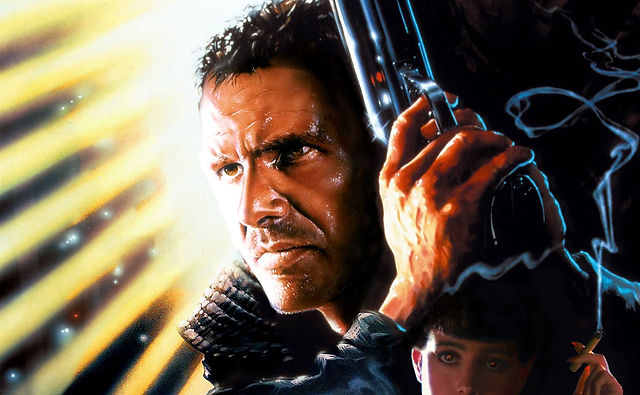
BLADE
RUNNER
Ridley Scott (1982)
by Augustin Denis - September 2017
Los Angeles, 2019: retired Blade Runner (special police force) Rick Deckard is dispatched to retire (kill) four escaped Nexus 6 Replicants, the most technologically advanced humanoid robots developed by the Tyrell Corporation.
DECKARD
Replicants are like any other
machine. They can be a benefit
or a hazard. If it’s a benefit,
it’s not my problem.
While we first follow Deckard during his investigation to find out where the Replicants are hiding, the movie shifts its focus towards the existential quest of the Replicants to meet their maker.
This shift occurs when Deckard starts questioning what truly defines human nature after having met Racheal, a Replicant unaware of its nature.
This shift is the representation of one of the main themes of the movie: questioning human nature. At first Deckard, is depicted as the embodiment of human nature. While after the shift of focus from Deckard to the Replicants, the Replicants come closer to being human and Deckard is dehumanized.
Deckard’s dehumanization comes across through his capacity to kill humanoids cold-bloodedly as well as through his behavior when alone in his apartment as he spends his time drinking and using different futuristic technologies. Deckard is associated with these tools to a physical extent as there are several shots where his eyes become the screen. On the other hand, the fact that the Replicants are obsessed by their existential question gives them relatable human attributes.
Several motifs come to support the questioning of human nature, the most evident of which being the recurrence of eyes in the movie. The saying that “eyes are the mirror of the soul” has never been so true than in this movie.
The first sequence of the movie is made up of shots of the city and close-up shots of an eye in which the city is reflected, indicating that the question of humanity is embedded in this future Los Angeles and by extension, in the movie.
The second sequence pursues this motif further by integrating it in the narration as the Voight-Kampff test used to detect Replicant focuses of the reaction of the eyes of the interrogated.

I could continue writing about all the instances and intricacies of this motifs for pages but I will finish with one last example which ties into another important motif of the movie.
When Roy meets his maker, he kills him by crushing his eyeballs, dispossessing him from his humanity while becoming more than human,shot through a low angle, following the Nietzschean principle of the Übermensch as he accepts his finitude. This sequence also evokes the parallel between Roy Batty and the incarnation of western human morals, Jesus Christ through the kiss he gives to his spiritual father before killing him. The Christian parallel is emphasized later when Roy jabs his hand with a nail. Through this parallel, Roy becomes not only human but more human than human. One could even say that in the end, Roy dies for Men’s sins, allowing Deckard to become the embodiment of human nature again as he flees Los Angeles with his lover Racheal, a Replicant.

This coincides with the moment where the audience is most led to question Deckard’s identity. Is he human or is he a Replicant? Through Deckard’s character, the audience is invited to question their own identity and what it means to be human, especially with the spectral character Gaff’s line:
GAFF
It’s too bad, she won’t last, eh!
The smile is real and a little sad.
But who does
By becoming more human than human, Roy also clashes with the tropes of the film noir. Blade Runner is a peculiar movie as it is both a film noir reusing the tropes of 1940s movies like The Maltese Falcon or Double Indemnity and a science-fiction movie. These tropes are for example the presence of a femme fatale through Rachael’s character or the idea that the main character is the incarnation of morality in an immoral environment, here Deckard having to retire the Replicants. However, these tropes are completely turned upside down in the movie as Rachael will end up helping Deckard, and Rick will be proven wrong as Roy will be presented as the character representing morality.
The play on the tropes of 1940s movies also has a cultural significance as can be interpreted as a criticism of the Reagan administration. Blade Runner was released in its first version in 1982 while Reagan started holding office in 1981. Reagan, before running for presidency, was well-known for acting in several westerns, the genre of which is well-known for its large amount of defined tropes during the 1940s. Thus, in the eyes of the public and in the way he depicted himself, Reagan was an incarnation of the morals of that time. Especially as there are certain similarities between the tropes of the film noir and the tropes of the western, as in both genres the main character is supposed to incarnate certain moral values which are threatened by his adversaries. By reusing and overturning the classic 1940s tropes it is going against everything Reagan represented at the time.

All the aforementioned points are part of the reason why Blade Runner has become a cult classic. There are many other ways to analyze this movie and I only barely evoked the aesthetics of the movie. It is very pleasing to come back to Blade Runner, as each time, new articulations and elements seem to fall into place and give new meaning to the overall scenes. However, even with the new perspectives that are revealed, the coherence and overall feel of the movie stays unaltered thanks to its aesthetic, atmosphere and style.



